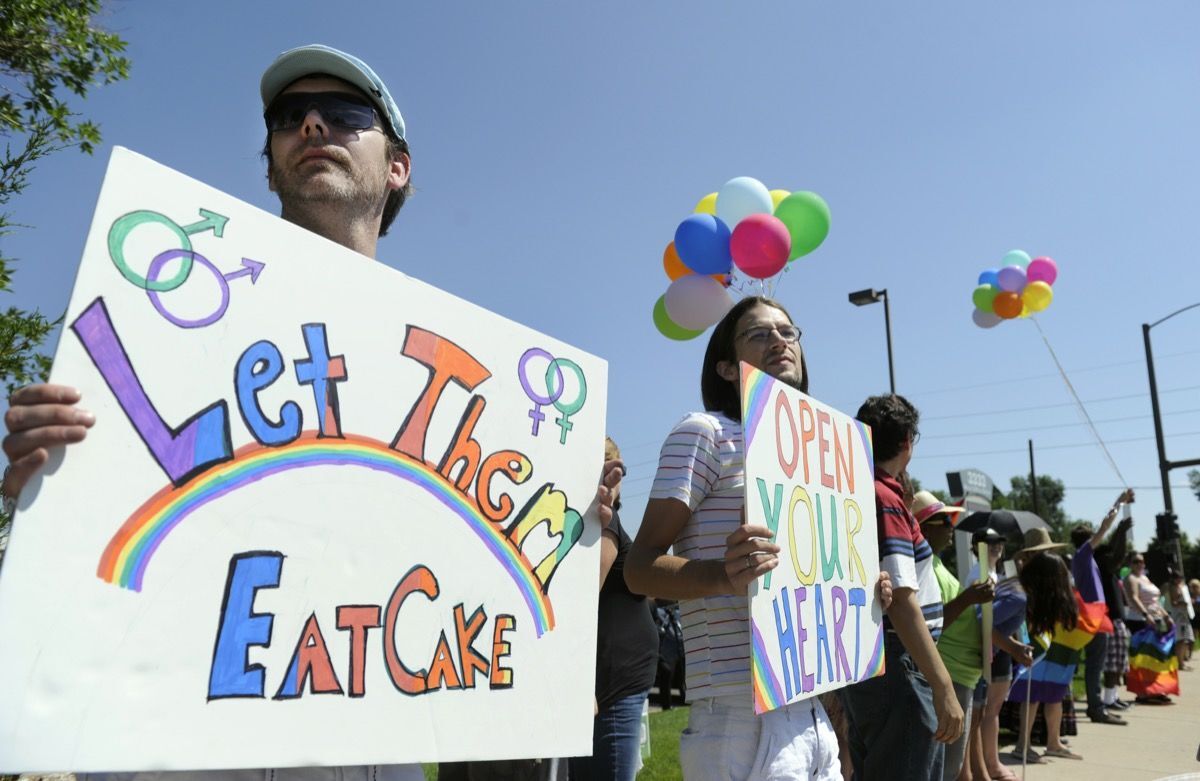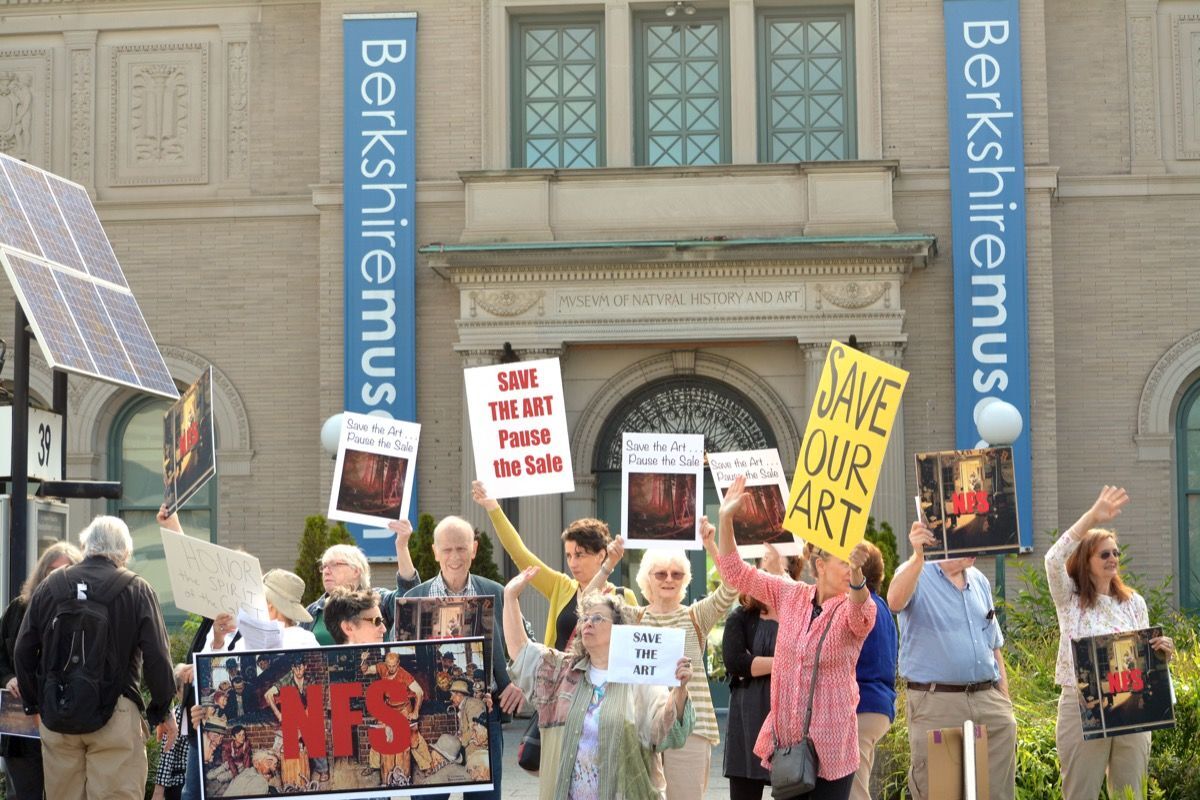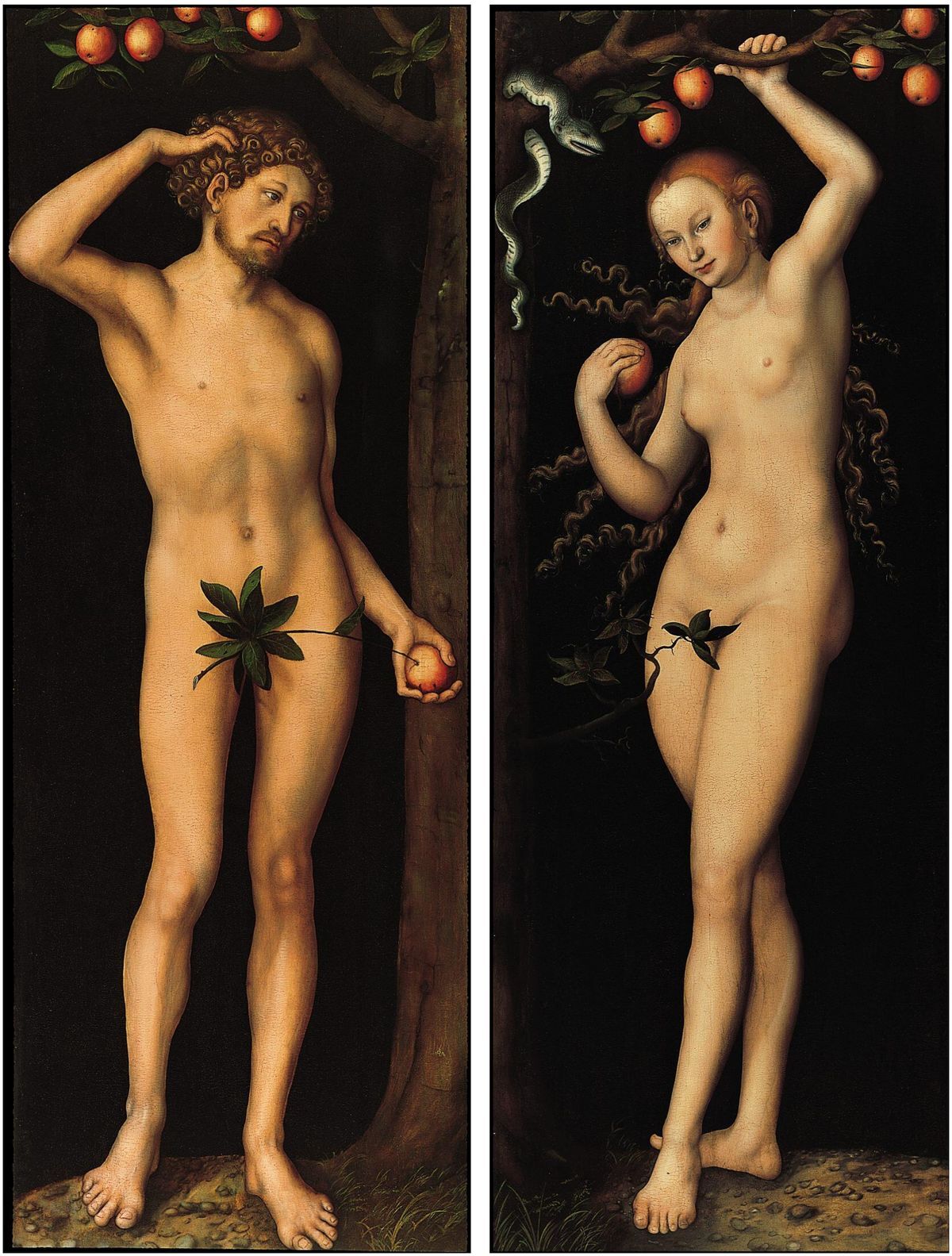Art Market
5 Lawsuits That Could Reshape the Art World in 2018
While 2018 will surely spark a whole new slate of lawsuits, some of the the new year’s most significant art-related cases are already pending. Here are five lawsuits dealing with everything from free speech to copyright infringement that we will be keeping an eye on.
Masterpiece Cakeshop, Ltd. v. Colorado Civil Rights Commission
Filed July 2012

Dave Mullins and Charlie Craig in 2012. Photo by Kathryn Scott Osler/The Denver Post, via Getty Images.
On December 5th of this year, the U.S. Supreme Court heard oral arguments in Masterpiece Cakeshop, Ltd. v. Colorado Civil Rights Commission. Among the questions raised by the case: Are cakes artworks? The query is an unexpected one to find at the heart of a major anti-discrimination lawsuit that pits a gay couple against the religious baker who refused to create a cake for their wedding, asserting it would violate his religious beliefs. In response, the couple, Charlie Craig and David Mullins, sued “cake artist” Jack Phillips, who runs a small bakery in Colorado called Masterpiece Cakeshop.
Craig and Mullins sued in 2012 and prevailed at the local and appellate level. But Phillips appealed, and now the Supreme Court has heard the case. The major issue at the heart of the lawsuit is the constitutionality of a Colorado law that bars business owners from discriminating against customers because of their race, creed, national origin, and sexual orientation, among other aspects of their identity. Phillips has argued that the law violates his first amendment rights by compelling him to “speak” by producing artworks (his cakes). In his brief to the Supreme Court, which compares cake art to the works of Alexander Calder and other artists, Phillips argues that the law regulates speech and as such needs to be subject to stricter court scrutiny that would see it ruled unconstitutional. The ACLU, which is representing Craig and Mullins, charge that the law does not regulate speech but simply mandates that businesses must treat customers equally, whatever product they’re selling.
Why it Matters:
The Colorado statute is similar to many anti-discrimination laws in states across the country, and the Supreme Court’s ruling in this case will impact those laws outside of Colorado as well. Effectively, should Phillips win, businesses, under the guise of artistic expression, could refuse to serve those in the LGBTQ community by arguing that service violates their religious beliefs. The argument advanced by Phillips is “an argument that the Constitution protects discrimination,” Louise Melling, deputy legal director for the ACLU, told Artsy.
Graham v. Prince et al
Filed December 2015
Absolutely no one will be shocked to find appropriation artist Richard Prince on this list. Prince is the king of copyright infringement cases. He’s been sued numerous times for using artworks created by others in his own work without permission or payment. He often wins these cases by asserting fair use—that is, his use of artwork created by others falls under an exception to copyright law reserved for the original transformative use of copyrighted works (though courts weigh other factors in determining fair use as well).
Prince broadened fair use in 2013 with Cariou v. Prince after an appellate court found that for appropriation to qualify as fair use it need only imbue the original work with some new meaning or message—even if that is intangible.
In the 2015 case Graham v. Prince et al, photographer Donald Graham sued Prince and his dealer, Larry Gagosian, after Graham’s 1996 photograph Rastafarian Smoking a Joint appeared in a work in Prince’s Instagram series exhibited at Gagosian gallery in 2014. Prince moved to dismiss the case, asserting fair use, but a judge shot down that motion in July 2017. Though a motion to dismiss comes with a high legal bar (the facts are interpreted in a way most favorable to Graham), the ruling “wasn’t good for Prince,” writesBill Donahue at Law360.
Why it matters:
Even after the 2013 case, the judge in Graham v. Prince found Prince’s total and full use of Graham’s image—without any alteration beyond adding some Instagram comments—does not lend itself to a clear-cut fair use argument. The case will now proceed to trial. If Prince loses (a big if) and the ruling is upheld on appeal (an even bigger if) the resulting precedent could reign in the broader fair use interpretation afforded to artists by the earlier ruling.
Berkshire Museum Lawsuits
Filed October 20, 2017 and October 26, 2017

Protestors at the Berkshire Museum in August. Photo by Gillian Jones for the Berkshire Eagle.
You have to wonder how many members of the artworld could point to Pittsfield, Massachusetts on a map before the Berkshire Museum announced in July that it would be auctioning 40 artworks from its permanent collection. The institution planned to use the estimated $60 million raised from the sale at Sotheby’s to fund renovations and boost the endowment—a clear-cut violation of industry guidelines around deaccessioning.
The sale brought condemnation from across the artworld, with the American Alliance of Museums and the Association of Art Museum Directors calling for a halt to the sale that would almost certainly see works by Norman Rockwell, Alexander Calder, and the other greats slated to be sold leave the public trust and enter private collections. Other observers, including the editorial board of the Boston Globe, argued the sale should be allowed to go ahead. For its part, the museum asserted it needed the funds to plug a financial hole and that it was pivoting away from fine art—recasting itself as a science and technology focused institution.
The lawsuits came flying. A group of Rockwell descendants sued to halt the sale, as did members of the museum, alleging the trustees were violating their fiduciary duty by auctioning the work. Those suits were dismissed on November 7th with a judge finding the plaintiffs didn’t have standing to bring the case. (The suit brought by the Berkshire Museum members has since been appealed.) A last minute intervention from the Massachusetts Attorney General’s Office (AGO) staved off the sale of the works, with an appellate justice ruling on November 10th that the Sotheby’s auction could not proceed so the suit could be adjudicated. A wide-reaching investigation into the museum by the AGO is ongoing.
Why it Matters:
However the suit ultimately turns out, its impact on the museum community is already massive. If the Berkshire Museum is allowed to sell, it could make it more difficult to prevent other museums from selling works in their collections to cover operating costs in the future. But even if the museum does win, the protracted, bitter, public, and ultimately embarrassing lawsuits—including the intervention of the AGO—means that institutions from Maine to California will think of what happened in Pittsfield before ever deaccessioning an artwork in violation of industry guidelines in the future.
The Guelph Treasure Case
Filed February 2015
The Guelph Treasure also deals with Nazi restitution, but the case is in far more nascent stages. The suit centers around the Guelph Treasure, named after the princely German House of Guelph, which was sold by a group of German-Jewish dealers in the lead up to World War II. A group of the dealers’ heirs—two of whom live in the United States (the third in London)—sued in an American court for the restitution of the works, arguing the sale was coerced by the Nazis. Germany moved to dismiss the case, arguing that as a sovereign state it is not subject to the jurisdiction of U.S. courts. But a district court disagreed, ruling in March that Germany would have to answer the claims. The case marks the first time Germany has had to face a restitution lawsuit in a U.S. court.
Why it Matters:
The appeals court ruling in the Guelph Treasure case will likely have broader legal significance on the scope of the Foreign Sovereign Immunities Act (FSIA), which prevents foreign governments from being used in U.S. Court. Over the past few years courts have broadened an exception to FSIA, known as the expropriation exception, finding that the exception applies if property, such as an artwork, was forcibly taken “in violation of international law” either as part of a genocide or in the lead up to a genocide. If the appellate court tosses out the Guelph Treasure case and narrows the applicability of the exception to FSIA, it would deal a serious blow to those looking to reclaim Nazi-looted art from state owned art in foreign countries.
Von Saher v. Norton Simon Museum
Filed May 2007

Lucas Cranach the Elder, Adam and Eve, circa 1530. Image via Wikimedia Commons.
Von Saher v. Norton Simon Museum is a long-running legal battle. In 2007, Marei von Saher sued the Norton Simon Museum in Pasadena, California, seeking the return of two works by Lucas Cranach the Elder held in the museum’s collection but which originally belonged to her father-in-law, Jewish art dealer Jacques Goudstikker. He was forced to sell the pieces before fleeing Germany in 1940. While both sides agree the paintings were looted by Nazis, Norton Simon has consistently argued that it holds legal title to the work.
The case has dragged on for years. Just weeks before a trial was supposed to finally begin in 2016, the judge hearing the case ruled that the Norton Simon Museum could keep the paintings in a move that surprised court observers. Von Saher appealed the ruling. The appellate court could finally put an end to this long running saga by either upholding the ruling of the lower court, or reversing it and finding in favor of von Saher without any trial; or it could kick the case back to a lower court and argue the trial needs to proceed.
Why it Matters:
The facts in the von Saher case are relatively specific (the case turns on the reading of certain post-war Dutch laws, for reasons you can read about here), meaning whatever decision the appellate court does reach won’t have broad legal ramifications. But given the publicity around the case, a triumph by von Saher could encourage more heirs to come forward with fresh restitution suits, with a loss having the opposite effect.
Isaac Kaplan is an Associate Editor at Artsy.

No comments:
Post a Comment